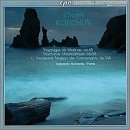| All Artists: Charles Koechlin, Deborah Richards Title: Charles Koechlin: Piano Works - Paysages et Marines (Landscapes & Seascapes), Op. 63 / Nocturne Chromatique (Chromatic Nocturne), Op. 33 / L'Ancienne Maison de Campagne (The Old Country House), Suite for Piano, Op. 124 - Deborah Richards Members Wishing: 0 Total Copies: 0 Label: Cpo Records Release Date: 1/25/1995 Genre: Classical Style: Chamber Music Number of Discs: 1 SwapaCD Credits: 1 UPC: 761203905423 |
Search - Charles Koechlin, Deborah Richards :: Charles Koechlin: Piano Works - Paysages et Marines (Landscapes & Seascapes), Op. 63 / Nocturne Chromatique (Chromatic Nocturne), Op. 33 / L'Ancienne Maison de Campagne (The Old Country House), Suite for Piano, Op. 124 - Deborah Richards
CD Details |
CD ReviewsSinuous pianistic epiphanies,wonderfully elegant,effulgence scarecrow | Chicago, Illinois United States | 09/12/2001 (5 out of 5 stars) "Koechlin's piano music can be divided into a few periods,although his discursive imagination seems to blur any hard and fast distinctions.
Robert Orledge in his marvelous comprehensive study on Koechlin divides the piano music into two periods. The first incorporating these seas interludes(1915-16), and the Les Heures persanes,(1916-1919). These works are more harmonically advanced polytonal and bi-tonalof which Koechlin had repremanded his student Darius Milhaud of the great distinctions between bi-tonal and polytonal. The second period encompasses more purely tonal, relatively simpler pieces as the "Quatre nouvelles Sonatines". Most of his piano music is not incredibly pianistic although he intimately knew the implications of that language,perhaps not terribly interested. For Koechlin's real genius power was timbre, orchestration.Akin to Maurice Ravel his contemporary was more strongly in that pianistic timbral world of discourse. For Koechlin it was the imaginative envois,elan,the phantasmagoric or fantasi content that excited and animated his works. These seas interludes are predictably spacious, with a plethora of open intervals, Fifths, Fourths, and slow. Their durational frames proceed, unfold with the utmost care for the pianistic decay. They have a luminous polytonal language, and amply render the differences where the horizinal spatiality meets, interfaces with the vertical. Koechlin's music may seem static, yet he I beleive creates differeing contexts, ones that Les Six had ignored,in favor of more direct expressive gestures. Long sinuous lines come to dominate these sea interludes,arabeque like,plainsong, and in Orledge's account has some affinity with art nouveau fashionable of the times in Paris. I prefer these to the "Les heures persanes"where his own orchestration of those 16 pieces for piano cast a giant shadow over the piano solo. These interludes are wonderfully suggestive. The earlier "nocturne chromatique" from 1907 is deeply dark,the effacacious wonder here is the slow introduction of tones that evoke the image. Again the music moves lugubriously,yet with a sense of disquitude,anxious,perceptive of possible dangers, with an electric sense of ongoing motion, there's nothing slothful here.Even toward the final moments we get blinding full fisted cathedral like chords. Something Messiaen is indebted to. Spaces are filled quite predictable with broken chordal sequences,yet with a self-possessed elan for the pure beauty of the piano timbre. Ms. Richards is not a stranger to the new, and has an impressive sense of Koechlin's enlightened sensitivity for the other-worldly epiphanies" |


 Track Listings (26) - Disc #1
Track Listings (26) - Disc #1